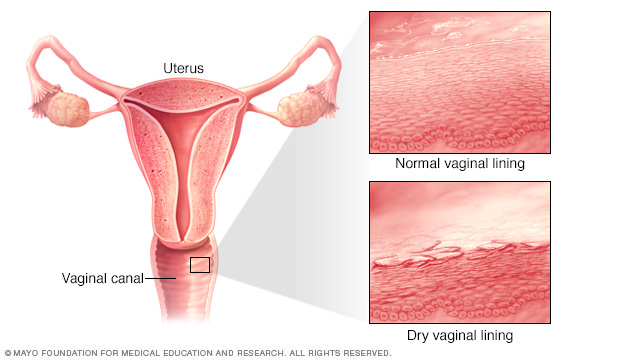Overview
Vaginal atrophy (atrophic vaginitis) is thinning, drying and inflammation of the vaginal walls that may occur when your body has less estrogen. Vaginal atrophy occurs most often after menopause.
For many women, vaginal atrophy not only makes intercourse painful but also leads to distressing urinary symptoms. Because the condition causes both vaginal and urinary symptoms, doctors use the term "genitourinary syndrome of menopause (GSM)" to describe vaginal atrophy and its accompanying symptoms.
Simple, effective treatments for GSM are available. Reduced estrogen levels result in changes to your body, but it doesn't mean you have to live with the discomfort of GSM.
Products & Services
Symptoms
Genitourinary syndrome of menopause (GSM) signs and symptoms may include:
- Vaginal dryness
- Vaginal burning
- Vaginal discharge
- Genital itching
- Burning with urination
- Urgency with urination
- Frequent urination
- Recurrent urinary tract infections
- Urinary incontinence
- Light bleeding after intercourse
- Discomfort with intercourse
- Decreased vaginal lubrication during sexual activity
- Shortening and tightening of the vaginal canal
When to see a doctor
Many postmenopausal women experience GSM. But few seek treatment. Women may be embarrassed to discuss their symptoms with their doctor and may resign themselves to living with these symptoms.
Make an appointment with your doctor if you have any unexplained vaginal spotting or bleeding, unusual discharge, burning, or soreness.
Also make an appointment to see your doctor if you experience painful intercourse that's not resolved by using a vaginal moisturizer (K-Y Liquibeads, Replens, Sliquid, others) or water-based lubricant (Astroglide, K-Y Jelly, Sliquid, others).
Causes
Vaginal dryness

Vaginal dryness
Typically, the vaginal lining consists of healthy tissues that are several layers thick and naturally moist. A dry vaginal lining becomes thinner and loses natural moisture.
Genitourinary syndrome of menopause is caused by a decrease in estrogen production. Less estrogen makes your vaginal tissues thinner, drier, less elastic and more fragile.
A drop in estrogen levels may occur:
- After menopause
- During the years leading up to menopause (perimenopause)
- After surgical removal of both ovaries (surgical menopause)
- During breast-feeding
- While taking medications that can affect estrogen levels, such as some birth control pills
- After pelvic radiation therapy for cancer
- After chemotherapy for cancer
- As a side effect of breast cancer hormonal treatment
GSM signs and symptoms may begin to bother you during the years leading up to menopause, or they may not become a problem until several years into menopause. Although the condition is common, not all menopausal women experience GSM. Regular sexual activity, with or without a partner, can help you maintain healthy vaginal tissues.
Risk factors
Certain factors may contribute to GSM, such as:
- Smoking. Cigarette smoking affects your blood circulation, and may lessen the flow of blood and oxygen to the vagina and other nearby areas. Smoking also reduces the effects of naturally occurring estrogens in your body.
- No vaginal births. Researchers have observed that women who have never given birth vaginally are more likely to develop GSM symptoms than women who have had vaginal deliveries.
- No sexual activity. Sexual activity, with or without a partner, increases blood flow and makes your vaginal tissues more elastic.
Complications
Genitourinary syndrome of menopause increases your risk of:
- Vaginal infections. Changes in the acid balance of your vagina make vaginal infections more likely.
- Urinary problems. Urinary changes associated with GSM can contribute to urinary problems. You might experience increased frequency or urgency of urination or burning with urination. Some women experience more urinary tract infections or urine leakage (incontinence).
Prevention
Regular sexual activity, either with or without a partner, may help prevent genitourinary syndrome of menopause. Sexual activity increases blood flow to your vagina, which helps keep vaginal tissues healthy.
Sept. 17, 2021